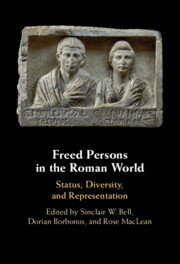Book contents
- Freed Persons in the Roman World
- Freed Persons in the Roman World
- Copyright page
- Contents
- Figures
- Table
- Contributors
- Acknowledgments
- Bibliographical Note
- Introduction
- 1 Permissu decurionum
- 2 Freed Public Slaves in Roman Italy and the Western Provinces
- 3 Fitting in by Decree
- 4 Doubling Up
- 5 The Cost of Ingratitude
- 6 Between Moral Slavery and Legal Freedom
- 7 Framing the Freed Person
- 8 Novel Evidence for Ancient Freed People
- 9 The Affects of Manumission
- General Bibliography
- Index
- References
Introduction
Freed Persons in the Roman World: Status, Diversity, and Representation
Published online by Cambridge University Press: 16 May 2024
- Freed Persons in the Roman World
- Freed Persons in the Roman World
- Copyright page
- Contents
- Figures
- Table
- Contributors
- Acknowledgments
- Bibliographical Note
- Introduction
- 1 Permissu decurionum
- 2 Freed Public Slaves in Roman Italy and the Western Provinces
- 3 Fitting in by Decree
- 4 Doubling Up
- 5 The Cost of Ingratitude
- 6 Between Moral Slavery and Legal Freedom
- 7 Framing the Freed Person
- 8 Novel Evidence for Ancient Freed People
- 9 The Affects of Manumission
- General Bibliography
- Index
- References
Summary
This introductory chapter places the volume within its wider academic context through discussion of its method, background, and content. First, the chapter frames the debates that gave rise to the collection and sets out the central research questions that the chapters address. Second, it summarizes the current state of the literature, including a discussion of how similar lines of inquiry have developed in different disciplines (archaeology, legal history, epigraphy, and ancient history). Third, it discusses the contents and significant conclusions of the volume by summarizing the chapters and then by highlighting the major commonalities between them. Fourth, it outlines the volume’s unique contributions to the debate and sketches avenues for future research.
Keywords
- Type
- Chapter
- Information
- Freed Persons in the Roman WorldStatus, Diversity, and Representation, pp. 1 - 29Publisher: Cambridge University PressPrint publication year: 2024

